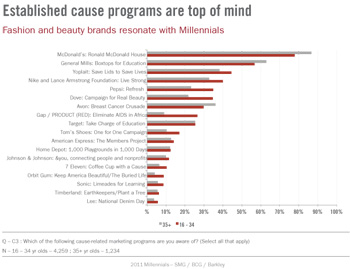Marketing to Millennials
Marketing to Millennials
Reach the Largest and Most Influential Generation of Consumers Ever
By Jeff Fromm and Christie Garton

Brands That Care
When it comes to building loyalty among Millennial consumers, one additional item for your tool kit is the ability to tap into their desire to make a difference in the world.
You don’t have to look far to find a study that highlights just how much this generation wants to make a positive impact. According to our survey, Millennials -aren’t volunteering any more -community–service hours than their parents did. But they are certainly expressing an overwhelming interest in making a difference and supporting companies that do the same. Indeed, our findings underscore just how much this generation’s purchase decisions are influenced by their opinions of a company’s -cause–marketing initiatives, with almost half of Millennial respondents saying they’re more likely to buy a brand they know supports a cause.
In light of the Millennials’ growing interest in supporting brands that give back, new companies like TOMS Shoes and FEED -Projects—-which helps provide meals to hungry children through every purchase of a -FEED–branded product through the company’s partnership with the United Nations World Food -Programme—-are thriving among Millennial consumers.
“We’ve been able to provide 60 million school meals to hungry children worldwide, while 46,000 kids in America have been directly impacted by our efforts,” says FEED Projects -Millennial–age cofounder and CEO, Lauren Bush (who also happens to be President George H.W. -Bush’s granddaughter). “Our success is measured by how many kids get fed.”
For brand managers who are searching for ways to engage Millennial consumers, it’s critical to show that you are a brand that cares. But proceed with caution. As we’ve said before, these savvy consumers have a good nose for phoniness. They know when you’re merely supporting a cause to sell your product. Pink and green labels alone won’t get you far with these consumers. “It’s not about slapping a ribbon on a product any longer,” said Carol Cone, executive vice president and -cause–marketing expert at Edelman, in a story Christie wrote for USA Today in 2011. They do want “deeper involvement in social issues and expect brands and companies to provide various means of engagement.” What the most successful companies have in common “is an overarching message and purpose, and they’re making it transparent.”
For companies that do get it right with Millennials, the upside is big. -Thirty–seven percent of Millennials say they are willing to purchase a product or service to support a cause they believe in, even if it means paying a bit more.
Cause campaigns that are currently winning with this generation include legacy campaigns such as Yoplait’s Save Lids to Save Lives with partner Susan G. Komen for the Cure (breast cancer) and a -youth–oriented campaign by Gap with partner Product (RED), fighting AIDS in Africa, which scored much higher among Millennials than -non–Millennials in terms of awareness, according to our recent research. See Figure 7-2 below.
These campaigns succeed because they have partnered with established, -well–respected charities. Given this trust, Millennials believe they can contribute to causes they care about more easily through these companies’ programs than through their own initiative. They also value charitable contributions through cause marketing because of the ease of participation and the scope of the impact that a -corporate–based charitable program can have in comparison to an individual donation.

“The success of companies like [FEED Projects] serve as a call to action to companies that it’s more than just the bottom line,” says Lauren Bush. “It’s a shift in what values matter most. It’s not just about making money; it’s about making the world a better place. I think consumers, especially young ones, are demanding that from companies today.”
Summing up, an affiliation with a cause is more important to the Millennial generation than to any previous generation. For a brand that is searching for ways to engage and tap into this next generation of consumers, showing them that you care is critical, but you must do so authentically.
“Don’t just talk the talk. Companies need to walk the walk,” Bush says.
When it comes to building loyalty with consumers who are not inclined -toward loyalty, the overall goal should be to “create an emotional connection with this -group—-a proven method of -driv-ing purchase behavior among Millennials.”
Do this through innovative products, packaging, and promotional programs that reflect this generation’s quest to look like they’re living well for less. Establish and grow loyalty among Millennial shoppers with a value proposition firmly founded on their rituals, needs, and wants. And play this out by prominently reflecting the value proposition across marketing programs and platforms.
Excerpted from Marketing to Millennials: Reach the Largest and Most Influential Generation of Consumers by Jeff Fromm and Christie Garton. Copyright ©2013 Barkley, Inc. Published by AMACOM Books, a division of American Management Association, New York, NY. Used with permission. All rights reserved.
Jeff Fromm and Christie Garton, AMACOM
Copyright © 2013 Barkley, Inc. All rights reserved.






